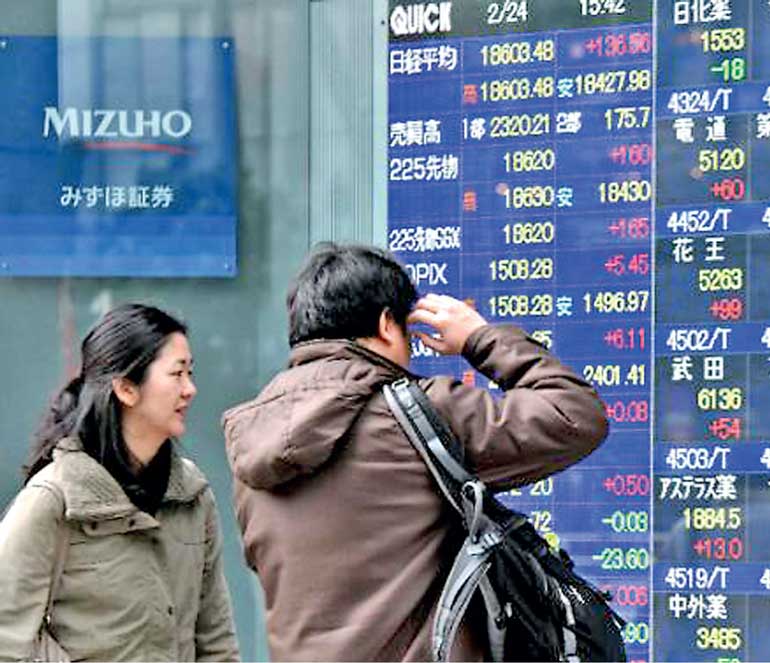Sunday Mar 09, 2025
Sunday Mar 09, 2025
Wednesday, 17 May 2017 00:00 - - {{hitsCtrl.values.hits}}
 Reuters: Asian stocks climbed to a fresh two-year high on Tuesday on the back of an overnight rise in Wall Street, while oil extended gains after major producers Saudi Arabia and Russia pledged to push for an extension of supply cuts into 2018.
Reuters: Asian stocks climbed to a fresh two-year high on Tuesday on the back of an overnight rise in Wall Street, while oil extended gains after major producers Saudi Arabia and Russia pledged to push for an extension of supply cuts into 2018.
Investors in regional equities, however, are growing increasingly wary as valuations look stretched and with the latest rally taking place in thin volumes and led by just a few sectors.
Regional stock markets were broadly mixed with Chinese stocks leading laggards and Thailand among the best performing stock market of the year. Europe is set to follow with index futures pointing to a mixed start.
“We are approaching a short-term resistance as the breadth of this rise is very unhealthy and the market momentum looks tired,” said Alex Wong, a fund manager at Ample Capital Ltd in Hong Kong, with about $130 million under management.
In Hong Kong, the broader market rose to its highest level since June 2015 on the back of extended buying into Chinese lenders and market heavyweight Tencent before declining 0.3%.
With overall volumes declining and share valuations looking extremely stretched, investors are growing cautious. Hong Kong’s technology sector, for example, is the most expensive, trading at a price-to-earnings multiple of more than 42 times.
MSCI’s broadest index of Asia-Pacific shares outside Japan was flat after hitting its highest level since June 2015 in opening trades.
Oil steadied around the $52 per barrel level after hitting its highest level in more than three weeks on Monday, after Saudi Arabia and Russia said that supply cuts needed to last into 2018, a step towards extending an OPEC-led deal to support prices for longer than first agreed. Global benchmark Brent crude rose 0.4% to $52 per barrel. US West Texas Intermediate (WTI) crude futures were up 0.4% at $49.03 per barrel.
Brent crude has gained nearly 9% over the last week though some analysts were sceptical about the durability of the rally despite the proposed supply curbs.
“That is going to be easier said than done, it appears, with US production running at its fastest pace since August 2015 and data yesterday confirming that Chinese growth momentum continues to moderate,” ANZ strategists wrote in a daily note.
Chinese growth cooled in April according to a variety of economic indicators ranging from factory output to retail sales as authorities clamped down on debt risks in an effort to stave off a potentially damaging hit to the economy.
In currencies, the US dollar nursed deep losses after a weak manufacturing report trimmed expectations of a Federal Reserve rate increase next month, a key factor behind the dollar’s gains in recent weeks.
The New York Federal Reserve’s barometer on business activity in the state unexpectedly fell in May, sinking into negative territory for the first time since October. “I think people want to wait and see,” said Teppei Ino, analyst for Bank of Tokyo-Mitsubishi UFJ in Singapore.
The euro edged up 0.2% to $1.0994 after gaining 0.4% on Monday. The dollar eased 0.3% against the yen to near 113.47, after rising 0.4% on Monday.
The dollar was steady at 98.83 against a trade-weighted basket of its peers after falling more than 1% in the last three sessions.
Expectations of a rate increase in June fell to 74% compared to 84% last week, according to the CME Fedwatch.
A risk-on undertone meant gold posted only meagre gains with the precious metal changing hands at $1,233 per ounce.
Discover Kapruka, the leading online shopping platform in Sri Lanka, where you can conveniently send Gifts and Flowers to your loved ones for any event including Valentine ’s Day. Explore a wide range of popular Shopping Categories on Kapruka, including Toys, Groceries, Electronics, Birthday Cakes, Fruits, Chocolates, Flower Bouquets, Clothing, Watches, Lingerie, Gift Sets and Jewellery. Also if you’re interested in selling with Kapruka, Partner Central by Kapruka is the best solution to start with. Moreover, through Kapruka Global Shop, you can also enjoy the convenience of purchasing products from renowned platforms like Amazon and eBay and have them delivered to Sri Lanka.
Discover Kapruka, the leading online shopping platform in Sri Lanka, where you can conveniently send Gifts and Flowers to your loved ones for any event including Valentine ’s Day. Explore a wide range of popular Shopping Categories on Kapruka, including Toys, Groceries, Electronics, Birthday Cakes, Fruits, Chocolates, Flower Bouquets, Clothing, Watches, Lingerie, Gift Sets and Jewellery. Also if you’re interested in selling with Kapruka, Partner Central by Kapruka is the best solution to start with. Moreover, through Kapruka Global Shop, you can also enjoy the convenience of purchasing products from renowned platforms like Amazon and eBay and have them delivered to Sri Lanka.